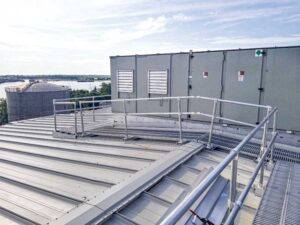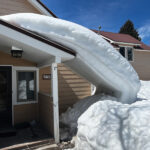
A successful rooftop walkway installation involves many factors. There are many variables to consider, including the type of rooftop, weather conditions, and requirements from the Occupational Safety and Health Administration (OSHA). There are three main considerations: how these walkways are designed; the materials used in their construction; and how they are installed on a rooftop.
Roof systems designs
A rooftop walkway system serves a few important functions. It simultaneously protects a roof from foot traffic damage and protects workers or employees from slips, trips, and falls by giving them a sturdy way to access rooftop equipment. Often there are certain safety features included in the design, such as non-skid grading, safety handrails (if required), and toe boards. Depending on the roof type, whether a standing seam metal roof or an R-panel metal roof, different installation techniques will be required.
Per OSHA, safety features on walkways require railings if workers are within 3 m (10 ft) of the roof edge. Railings are also a good idea if there is a higher pitched roof system (i.e. for 2:12 to 6:12 roof pitches). Make sure the rooftop walkway supplier can provide proof their railings have been independently tested to meet or exceed the OSHA 90.7-kg (200-lb) lateral load testing standards. Remember to find out if this is required on any project.
Materials vary
The components that make up the system can be made from a variety of materials. These materials include galvanized steel, Galvalume, aluminum, and stainless steel. Galvanized steel construction is the most common material used for walkway grating. It is strong, durable, and
corrosion resistant.
Installation of the roof
There are also two key factors to consider in the installation of the roof itself. First, look at the type of roof panel being used. Many metal buildings use standing seam roofs. In this case, it is important to avoid damaging the roof panel with the walkway system. Many companies choose to use non-penetrating seam clamps to avoid penetrating the rooftop or voiding any roof warranty. The style of clamp needed will vary based on the manufacturer and the profile of the roof panel.
Second is the pitch of the roof. Often, it is possible to pitch-correct the walkway system so it provides a level walking surface. It is important to speak with any supplier before specifying a walkway to check whether the system can be pitch-corrected, and to what degree.
Other questions to consider include the following: “What kind of warranty is included with the system?” “Can professional engineer- (PE-) stamped drawings be provided?” Some companies can provide PE-stamped drawings for all 50 states. (Not all companies may do this. Sometimes this is required by local code or municipalities, but not always.)
Taking the time to consider these factors when specifying a rooftop walkway system will help to ensure a successful project from beginning to end. Companies will also have peace of mind, knowing that whoever must set foot onto that rooftop will be able to do so safely and securely.
Cody Fox works with marketing and sales at Design Components, Inc.





